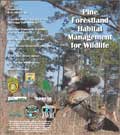Game Animals
Non-game Animals
Habitat
Pine Forests
- Pine forests can be managed for timber production, aesthetics, recreational purposes, and wildlife habitat
- Some of the wildlife game species that use pine forests are wild turkey, bobwhite quail, and white-tailed deer
Habitat Description: Pine Forests
There are numerous species of pines throughout southeast. Loblolly, shortleaf, slash and longleaf pine are the most common in Mississippi. Pine forests produce a number of renewable natural resources, including timber, watershed, erosion protection, wildlife and recreation.
Although pines can reproduce through natural or artificial means, a strong selected forestry program greatly improves long-term management options. By following a good forest management plan, landowners can protect wildlife while also taking advantage of valuable timber harvests. Combining forest management techniques such as clear-cutting, selective harvesting and prescribed burning is recommended.
Forest management techniques used to harvest timber create forest openings needed to support wildlife. The openness created by harvesting provides habitat for a large and diverse group of species. Forest openings also allow for a considerable amount of sunlight to reach forest floors which helps stimulate the growth of many native grasses and plants.

Natural Regeneration of Southern Pines (PDF)
Department of Forestry, Mississippi State University
There are two types of techniques used for natural regeneration of pine forests: uneven-aged management and even-aged management. This publication discusses the different silvicultural methods employed to get natural regeneration of pines in southern forests.

Are My Pine Trees Ready to Thin? (PDF)
Mississippi State University Extension Service
Every pine plantation is different, but there are many factors to consider when deciding when to thin your pines including site productivity, planting density, genetics, and weed competition. Consider these when deciding when to thin your pines: tree diameter, stand density, tree height, natural pruning, and growth rates. This publication discusses these points in detail so that you can better make the decision to thin. When to plan the second thinning is also covered.

Managing for Multiple Use (PDF)
Department of Forestry, Mississippi State University
Forests can be managed for multiple uses including timber production, aesthetics, recreational purposes, and wildlife habitat. Managing timber land for wildlife habitat can be easily incorporated into a forest management plan. This publication discusses wildlife management principles, managing for game animals, and economic considerations of wildlife management.

Managing the Family Forest in Mississippi (PDF)
Department of Forestry, Mississippi State University
This 100-page publication covers everything from developing a management plan to harvesting timber to forest health. It includes a sample management plan, photos and illustrations to support the text, and detailed tables and fillable forms.

Pine Forestland Habitat Management for Wildlife (PDF)
Mississippi State University Forest and Wildlife Research Center
Pine forests can be managed to provide wildlife habitat using a variety of techniques, some of which can improve timber stand quality. Established stands can be managed with thinning, prescribed fire or disking, and even herbicide control of hardwoods which can provide food and cover for quail and grassland species, deer, rabbits, turkey and other wildlife. Regenerating stands can be managed to provide weeds, legumes, and grasses that benefit quail and other early successional wildlife species. Even former agricultural fields can be managed for grassland habitat in conjunction with pine production to include wildlife habitat.
Forest Management Planning (PDF)
Utah State University Extension
This fact sheet discusses what forest management planning is, why planning is beneficial for forest landowners, and how to go about preparing a forest management plan.
Timber Management for Wildlife 101 (PDF)
West Virginia Wildlife
This article discusses managing timber to improve and maintain wildlife habitat.
A Loblolly Pine Management Guide: When and Where to Apply Fertilizer (PDF)
USDA Forest Service
Growth rates in loblolly pine (Pinus taeda L.) stands can often be increased markedly by applying phosphorus, nitrogen, or nitrogen and phosphorus fertilizers. On phosphorus-deficient Lower Coastal Plain sites, the growth improvement from phosphorus fertilization of loblolly pine often amounts to an increase in site index (age 25) of 15 feet. Nitrogen and nitrogen plus phosphorus fertilization produces 200 to 250 cubic feet of additional wood in the 5 years after application mostly on larger diameter trees.
A Loblolly Pine Management Guide: Natural Regeneration of Loblolly Pine (PDF)
USDA Forest Service
For many landowners, low cost makes natural regeneration an attractive alternative to planting when loblolly pine stands are harvested. Clearcutting, seed-tree, shelterwood, and selection methods can be used. Keys to success are a suitable seedbed, an adequate seed supply, sufficient moisture. and freedom from excessive competition.
Standing dead trees are called snag. They often have cavities or holes in them that provide nesting habitat and homes for birds and mammals like squirrels and bears, food and homes for woodpeckers, homes for salamanders and frogs and a multitude of insects.

